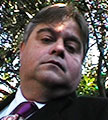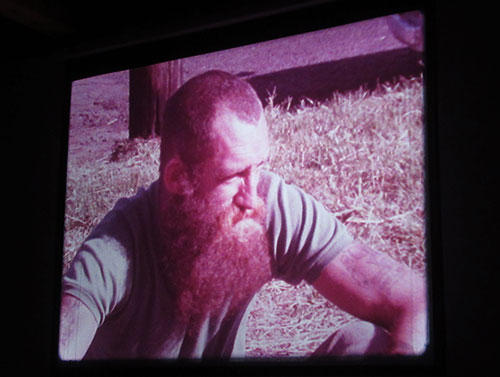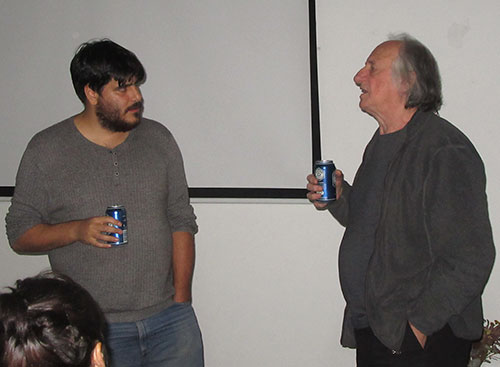Peter Tammer – Struttin' the Mutton by Nicholas Nedelkopoulos |
 |

Struttin' the Mutton (dir: Peter Tammer, 17 mins, 1975) |
Peter Tammer Retrospective 1 & 2, Artist Film Workshop, April 17 and 19, 2018 It was Friday, traditionally the last day of the working week. The pubs would swell with patrons who, over the Friday afternoon drinking sessions, would get increasingly drunk and rowdy to the point that arguments would eventually turn into fights. The newly arrived migrants would be at least superficially welcomed to assimilate into the frame like the Italian migrant character, the bemused and confused Nino Culotta in John O’Grady’s book They’re a Weird Mob and in the same–titled Michael Powell 1966 film adaptation. He (Culotta) after work would be dragged into the local watering hole to be initiated into his new Australian life with his new Australian mates. Through the 1950s, '60s and '70s there seemed to be a lot of drinking, fighting, spitting, pissing in public and vomiting, and there was always a special occasion to welcome more of the same debauched activities. And when you think about it there was a good reason for the tiled floors and walls in the old public bars of the pubs of that time. And that was for the publicans to be able to hose them down clean which tells us that they expected uncouth behavior to be part of the ritual of drinking in a venue like a pub (the watering hole). And there was the ‘no spitting’ signs like the ones that were in the pedestrian under paths coming out of Flinders Street Station, to enforce the type of society Melbourne was. It has now gone from ‘no spitting’ to ‘no splitting the bill’ and from ‘MSG’ to ‘GST’. Now that is Advance Australia Fair. It was a sunny Friday afternoon April 20th 2018 and I was sitting on a public bench facing the Windsor Station and reflecting on the Peter Tammer Retrospective. On the right side of me (Chapel Street) was a power pole but I quickly realized that it was a dreadful piece of public art. And meanwhile on my mobile phone was a friend sharing his observations of the Sydney Biennale saying it had been criticized for being ‘for the select’. In front of me was an endless stream of private secondary school students heading down the ramp to the station. When it appeared that there were no students left to be seen, another flow of secondary students appeared and this was repeated a number of times. It really was a endless sea of students (it was like being stopped at the railway gates watching live stock being freighted on train carriages passing endlessly by). A glimpse of the future was in front of me, these young people were our future and I wondered what was on their minds when they got on those congested trains, would they manage the country better then those in power now or were they going to play their part in its demise. There was one thing that I was sure of: I was not going to catch that train. It was a simple, crude and an isolating place (the Post Second World War Australia). It was this that Peter Tammer was able to capture in his early films. Take Struttin’ the Mutton in which we see three men sitting on the footpath of an inner Melbourne suburban street, drinking Fosters longneck beers. One in a floral shirt (Mark Gillespie) with a soft complexion and the other with a rough exterior (Danny Kramer), who was a man who could never be lost for words as he blabbed on and on. The third man a blander, quieter man who eventually disappeared into the house. The more alcohol poured down the throat of Kramer the coarser his conversation and behavior became and the further away Gillespie moved from him so that eventually he (Gillespie) was almost back in the safety of his home. At one point Kramer walked over to the gutter and relieved himself resulting in older female neighbors retreating in disgust into their homes. Kramer was not a character in Tammer’s film – he was the subject. No script, no improvisation – this was Kramer being himself. (An early form of reality TV with the reality kept, and on film unlike today's Reality TV programs, which are contrived and without any touch of reality or beneficial purpose.)
What was apparent (to me) was that Kramer was courting Gillespie. Kramer was parading his masculinity in front of Gillespie in the hope that he would win over Gillespie into having sex with him. Like a peacock, but instead of feathers Kramer was struttin’ his mutton. The sexual relationships between men in post war Australia were based in and on physical violence, which was commonly practiced in prisons. The lack of women in early settlement Australia had a profound effect on how women and men related to each other for many years to come. They were generally segregated to spend most of their time with their own gender. We see this in an understated way in Tammer’s Struttin’ the Mutton as all the main characters are men while in the background the neighbors are women. Tammer (on the night of the screening) described Kramer to be a ‘free spirit’ (a man without boundaries) and admitted to be scared of him. He had good reason to be. In Michael Harden’s book Lygon Street it mentions a rumour that Kramer had knifed someone at the front bar of the Albion Hotel while Phil Motherwell (b. 30 December, 1946 – d. 9 November 2014) recalls, “I never forget the night Danny Kramer attacked me. It was after the show had opened and I was feeling a bit funny about playing the woman. I’d sort of made the decision really quickly and I wasn’t really mentally prepared for being a female in public. So there I was about to go on and suddenly there’s this guy attacking me for doing it – right before the show – so I got the baseball bat out and when he saw me coming, this thing in a feather boa, eye patch and lipstick, he took off!”. Kramer was not a fictional character but a homeless alcoholic who drifted around Carlton scabbing beer money from the intelligentie. If there wasn’t a day I didn’t see Kramer I would hear about him. Recently I confused the names of Kramer and Spooner both sharing the same Christian name (Danny) because both were often talked about in Carlton circles in the '70s. I don’t how I could have done that – maybe it’s time and old age. Danny Spooner (b. 16 December 1936 – d. 3 March 2017) was a folk singer (and a historian) who arrived in Australia in 1962 and often performed at Frank Traynor’s and was involved with the revival of the Melbourne folk scene. He lived in Daylesford and performed leading up to the week before his death. He was 80 when he died. Mark Gillespie was to become a highly regarded and well–respected musician/songwriter who was to release four albums: Only Human (1980), Sweet Nothing (1981), Ring of Truth (1983), and Flame (1992). He would have notable musicians perform on his recordings and his live performances, just to name a few: Joe Creighton, the late Ross Hannaford, Mark Meyer, Rex Bullen, Liza Bade, Tim Partridge, Trevor Caintney, Andrew Thompson, Grey Lyon, Nicky Nicholls, Renee Geyer, Venetta Fields, Geoff Bridgeford. I note that, for the photography on the album Only Human, it was taken by Jacqueline Mitelman. I first met Mitelman in the early '70s at Prahran College of Advanced Education. She was a photography student and I remember being in the darkroom when her first colour print was printed – she was upset that the colour wasn’t right but it was fabulous print for its fantasy, dream like quality, a lovely print. Mark Gillespie had written short stories and co–founded Outback Press. He completed a six–year architecture degree at the University of Melbourne. He left behind the music scene decades ago to work in an orphanage in Bangladesh and continues to write songs and has written a text–message novel titled No Hope. 
Peter Tammer’s enthusiastic (near bursting) and informative presentation was a delight. He is 75 years old and has no dull tendencies. He is great communicator as not only did we get an Australian history lesson through his films but also a master class in early independent (low budget) filmmaking. As he said on the first night, he was learning as he was making them. Every film owed a lot to the ones he made before, progressing from wild soundtracks to lip–sync. There is so much more one can write about Tammer’s films and about Tammer. I have only focused on one film. Chris Luscri did a good job as the mediator. The A & Q was intelligent and lively and it was good to see so many filmmakers. Of those I could recognize: Nigel Buesst, Michael Lee, John Cumming, Dirk de Bruyn, Heinz Boeck, Maggie Fooke, John Hughes, David King, Kim Miles, Bill Mousoulis and Richard Tuohy. Written by Nicholas Nedelkopoulos 24 April 2018.
Dr Nicholas Nedelkopoulos is a noted artist with an extensive career who has amassed a large volume of experimental films. He has a broad interest in highbrow and popular Australian and overseas culture.
|
Published May 2, 2018. Originally published on the author's Facebook page, April 25, 2018. © Nicholas Nedelkopoulos 2018.
|